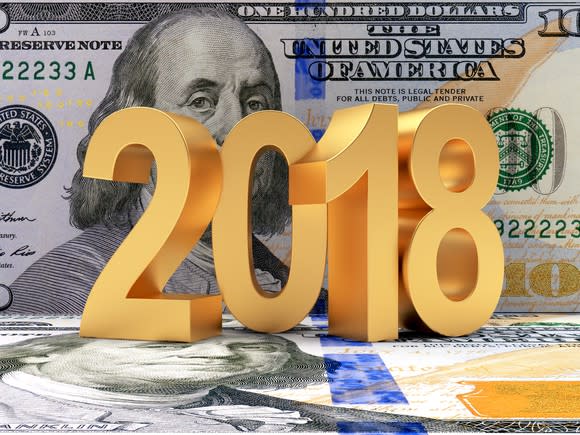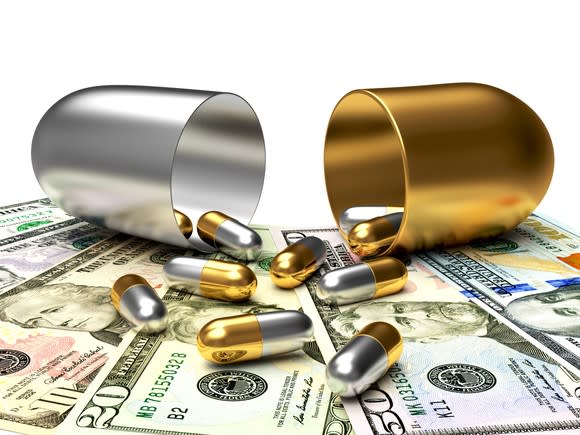Here Are My 3 Top Trades for 2018
After a rip-roaring performance in stocks last year, investors are right to wonder what could be in store in 2018. Will markets continue their winning ways, or are investors due for a reckoning? While anything can happen, I believe these three big trends offer investors a good shot at market-beating returns this year.
No. 1: Own some oil
After peaking in 2014, oil prices collapsed. Recently, they've been marching higher again, and I expect that trend will continue as global economic growth picks up this year.

IMAGE SOURCE: GETTY IMAGES.
Emerging economies will enjoy the highest growth, but the economic outlook is solid for the biggest oil-consuming countries, too. The U.S., China, Japan, India, and Russia account for more than a third of worldwide oil demand, and each is expected to see GDP increases this year.
The World Bank estimates that China's GDP will grow 6.4%, India's GDP will accelerate 7.3%, and Russia's GDP will increase 1.7% this year. Elsewhere, Japan's second-longest period of expansion since World War II is expected to continue with growth of about 1% in 2018. Meanwhile, the Conference Board expects U.S. GDP will improve 2.9% this year compared to 2.3% in 2017.
Greater economic activity will benefit many sectors, but I think it will be particularly good news for shareholders of oil-centric stocks, many of which still trade far below their 2014 peaks despite the ground they've regained over the past few months.
If you want diversified exposure to the oil patch, then the Energy Select Sector SPDR (NYSEMKT: XLE) may be a good bet. Its top holdings include ExxonMobil (NYSE: XOM), Chevron (NYSE: CVX), and Schlumberger (NYSE: SLB). However, if you prefer investing in individual stocks, then I favor ExxonMobil for its global exposure and 3.5% dividend yield, or one of the beaten-up energy service companies such as Diamond Offshore (NYSE: DO), an offshore driller that could finally see a pickup in demand if commodity prices cooperate.

IMAGE SOURCE: GETTY IMAGES.
No. 2: Buy big pharma
Big pharmaceutical stocks aren't as sexy as their biotech cousins, but that might not be a bad thing for investors in 2018.
While biotech stocks have seen shares soar on advances in precision and personalized medicine, big pharmaceutical stocks haven't rallied nearly as much -- and that could be creating an opportunity, especially for income-oriented investors. Many big pharmaceutical companies can be bought at a significant discount to the S&P 500's P/E ratio. For instance, you'll only pay about 13 times forward earnings to buy Pfizer (NYSE: PFE), a pharmaceuticals giant that's paying investors a market-trouncing 3.5% dividend yield.
Pfizer's been weighed down for years by declining revenue for its cholesterol-lowering drug, Lipitor. Lipitor was once the world's best-selling medicine, but it lost patent protection in 2011, and Lipitor's sales have been weighing on Pfizer's results ever since. In 2018, Lipitor's sales have finally fallen to a point where further declines won't present nearly as stiff a headwind. As a result, rising demand for Pfizer's expanding lineup of cancer drugs should provide the company with meaningful top-line growth this year, which it can then leverage against its past cost-cutting for higher profits.
While Pfizer is my favorite big-cap pharmaceutical stock to buy, investors seeking more diversification can consider adding the iShares U.S. Pharmaceutical ETF (NYSEMKT: IHE) to their portfolio. It invests in 43 different pharmaceutical stocks of various sizes, but Johnson & Johnson (NYSE: JNJ), Pfizer, and Merck & Co. (NYSE: MRK) are its three biggest positions; combined, they represent more than one-quarter of the fund's assets.

IMAGE SOURCE: GETTY IMAGES.
No. 3: Profit from productivity
With U.S. unemployment hovering near 4%, companies will need to turn to technology if they want to increase their productivity. There's simply not enough slack in employment for companies to rest on their heels. Instead, they'll have to embrace solutions that eke out more productivity from their current employees.
And that brings me to my third trend to buy: software stocks.
As companies look for ways to produce more goods and services for less money, that should provide natural revenue tailwinds for big software companies that sell software productivity suites, such as Microsoft (NASDAQ: MSFT), as well as niche productivity software companies such as Atlassian (NASDAQ: TEAM), which markets HipChat, a team messaging solution, along with other team-oriented software.
Customer relationship management software companies like Salesforce (NYSE: CRM), finance and human capital software companies like Workday (NASDAQ: WDAY), and companies that market manufacturing software, such as SAP AG (NYSE: SAP), could all see sales grow because of the need for companies to boost their productivity. The cut in corporate tax rates adds conviction to this investment idea by providing companies more financial wiggle room to make these investments.
You could buy any of these individual stocks to gain exposure to the productivity trend, or you could buy the iShares North American Technology Software ETF (NYSEMKT: IGV), which has about a third of its money invested in Adobe (NASDAQ: ADBE), Microsoft, and Salesforce.
Overall, while there's likely to be a lot of interesting and profit-friendly trends to profit from in 2018, I think oil, pharmaceuticals, and software are the most compelling trades to consider putting on now.
More From The Motley Fool
Teresa Kersten is an employee of LinkedIn and is a member of The Motley Fool's board of directors. LinkedIn is owned by Microsoft. Todd Campbell owns shares of Adobe Systems, iShares S&P; GSTI Software Index, Microsoft, Pfizer, and Salesforce.com. His clients may have positions in the companies mentioned. The Motley Fool owns shares of and recommends Atlassian, Johnson & Johnson, and Workday. The Motley Fool recommends Adobe Systems and Salesforce.com. The Motley Fool has a disclosure policy.

 Yahoo Finance
Yahoo Finance 